Baking foil: how to choose and use?
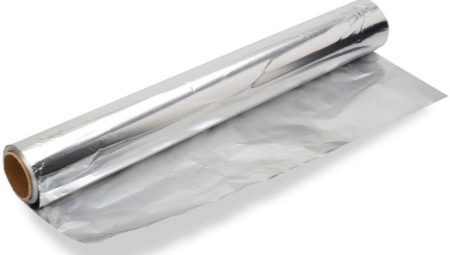
Foil can be found everywhere. Not without her in the culinary business. Since the invention, foil has not only helped to efficiently prepare food, but also to store it correctly. Everything is explained by the mass of useful properties and features. Thanks to this, all dishes prepared with foil will be tasty and aromatic.
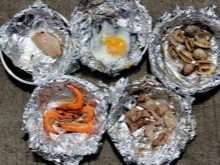

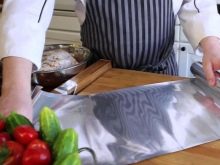
Peculiarities
Foil is a thin metal sheet similar in thickness to paper. The sheet will be shiny on one side and matte on the other. This is due to the peculiarities of its creation. Foil is made from aluminum, and a large share of such production falls on food. To do this, aluminum ingots pass through a rolling mill - in which they are repeatedly passed through rolls and their thickness is reduced.
In order to get the foil in its usual form at the last stage, two blanks pass through the rolls at once at the same time - that is why one side is more shiny.

After trimming, it is wound on plastic or cardboard tubes. Most often, the finished roll is wrapped in film or packed in oblong boxes.
Food foil has the following properties:
- easily bends, crumples and takes any conceived shape, but at the same time remains quite strong;
- resistant to corrosion, so it can come into contact with products;
- opaque, keeps the contents from ultraviolet rays;
- heat-resistant (this applies to both positive and negative temperatures);
- when used correctly, it is absolutely safe for humans, does not contain toxins and other harmful substances;
- environmentally friendly (it can be disposed of without harm to nature).
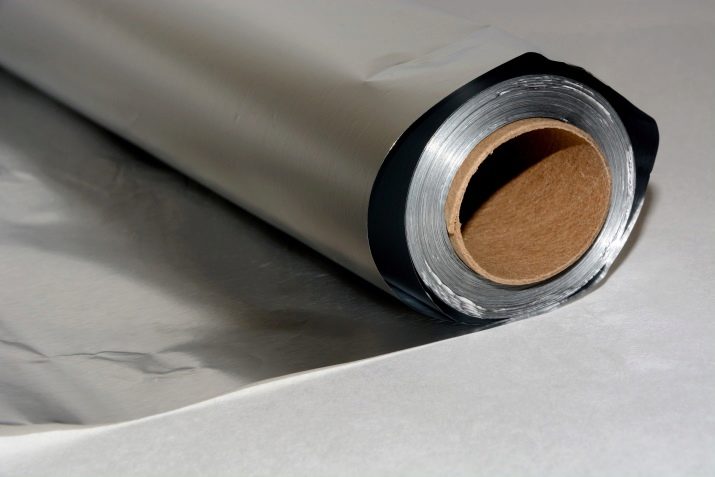
Benefit and harm
Useful properties of foil are manifested in the following:
- it is quite capable of replacing baking dishes, storage containers and many other kitchen utensils;
- it is convenient to use - wrapping and removing products does not take much time;
- food cooked in foil can be cooked without oil, so it can be safely included in the healthy nutrition menu, thus the products retain the maximum useful properties;
- products cooked in foil do not lose their taste, do not change the smell;
- it speeds up food preparation and keeps dishes clean, saving energy and time;
- does not harm the human body and the environment.
There are many myths about the dangers of foil. However, they have no practical evidence.

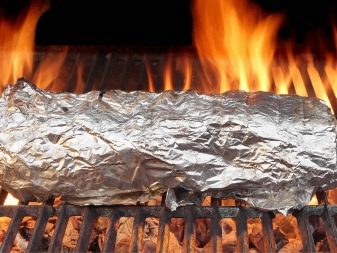
Many people draw an analogy between aluminum foil and dishes made of the same material. Here, the possibility of oxidation on contact with salts and acids is alarming.
In this regard, it is forbidden to cook and store smoked meats, meat or fish with sauces in foil, and some fruits. However, this is only possible under conditions of high concentration and long shelf life. You can find many experiments when, upon contact with meat pickled in vinegar, there was no reaction from the side of the foil coating. The concern is caused by the accumulation of aluminum in the human body. But even this is debatable. Even with frequent use, only a small amount of aluminum can enter the body and there will be no harm from it.
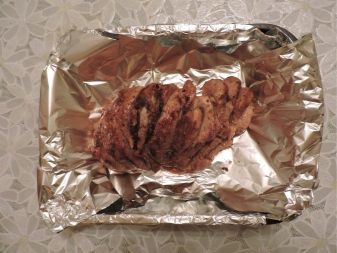
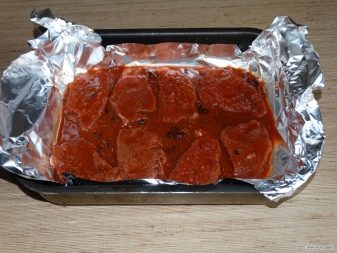
How to choose?
To avoid mistakes in the process of purchasing baking foil and not to be disappointed during use, it is necessary to pay attention to several nuances.
- The length and width of the web is the same for different manufacturers, but the thickness may vary. This value does not affect the quality of the food or the cooking time, but the thin sheet is much easier to damage. To avoid this, you will need several layers, the roll will be wasted uneconomically.
- Important qualities for any foil are strength, shape stability and resistance to product scorching. If the roll rolls out well and does not break, the rolls do not unfold spontaneously, and the food does not stick to the surface of the sheet - the quality can be called good.
- In stores you can find different names - for grilling, for baking, food, universal. In its properties, if it differs, then it is insignificant. Any of the varieties presented can be used for storing and preparing food.
- Some manufacturers produce products with a non-stick effect, matte on both sides, or even embossed. But practice shows that all these innovations are no different from the traditional version.
- The price spread also confuses buyers, because the cost can be measured in tens or hundreds of rubles. Despite the bright packaging and tempting advertising, you should not overpay - the inside is the same.
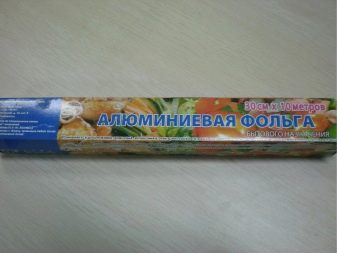
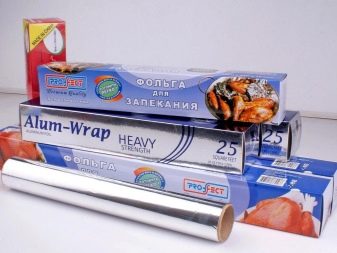
How to use foil?
Various types of meat, chicken, fish and vegetables can be cooked in foil. With the help of metal sheets, they can be easily baked in the oven or multicooker. Foil reduces the frying time in a pan or grill several times, while the products are cooked in what is called "in their own juice." If a baking sheet, frying pan or other container has a special coating, cooking is possible, but the actions should be as careful as possible. It is also worth remembering that such products are strictly prohibited for microwave ovens.

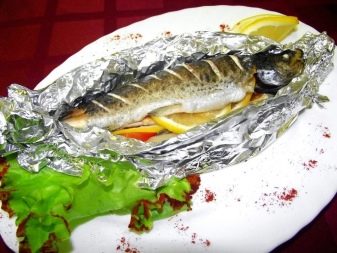
The most popular use for foil is wrapping.
This can be done arbitrarily (tightly twist the sheet around the piece and press) or build a kind of bag out of foil. To do this, you must perform a certain algorithm of actions.
- Cut off a piece of foil that is twice the size of the product plus allowances on the sides. The metal blade is easily cut with a knife or scissors.It can be torn with your hands, and to make the cut even, you should use the edge of the table.
- The matte side is believed to be better at letting heat through, so it should be on top. Place the products on half of the glossy side of the cut fabric and cover with the rest.
- To maintain tightness, all the sections must be connected in pairs and wrapped several times. If the foil is torn, there should be several layers - this is especially true for fish and poultry carcasses with protruding parts.
- Next, the bag is placed on a baking sheet. For convenience, all manipulations can be done immediately on it.
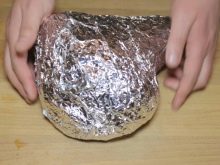

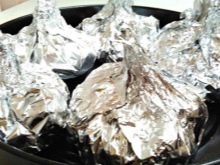
You can also line the baking tray with metal sheets. It is correct to lay on it with the glossy side up, as food sticks to it less. But this situation is not fundamental, since it has long been proven that the difference in absorption and reflection of heat between both sides is very small.
If the dish is not dietary, the sheet should be oiled.

A full baking dish can be made from a metal sheet. To do this, you need a suitable container, on which several layers are applied at once. First you need to knead the bottom well, and then the sides. Next, the workpiece is removed and unnecessary edges are cut off. To make the shape more accurate, they can be bent to the desired height. Small molds are made in the same way, they can be both round and curly. So that the liquid does not evaporate, and the dish is baked well, you can cover the mold on top with an aluminum sheet - it will replace the lid. These containers can be used for storage and transportation. The more layers, the harder the tray will be.
Foil pouches can be made for portioned meals. For this, food is placed in the center of the sheet, then the edges are raised and twisted for reliability.
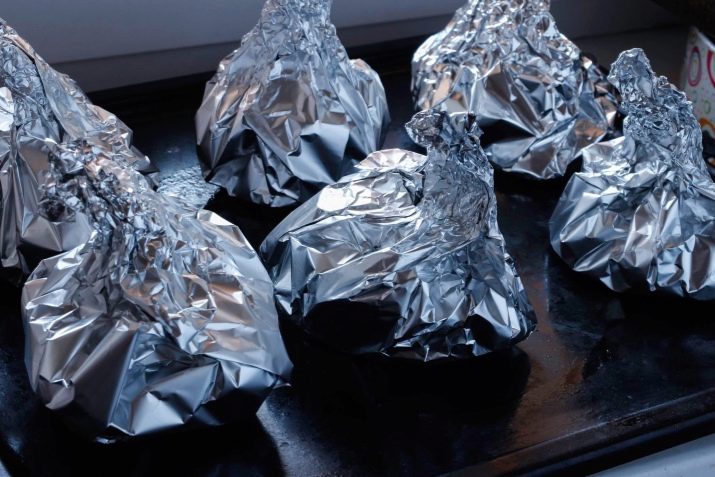
Another option is boats. For them, you need to put several rectangular sheets on top of each other. Then they should be pinched on both sides to form the bottom and walls. It is believed that foil can be used on a fire or grill. But in this case, you need to be careful - on an open fire, the foil can burn out. Therefore, it is better to cook meat or vegetables on charcoal and carefully monitor the process so as not to spoil the dish.

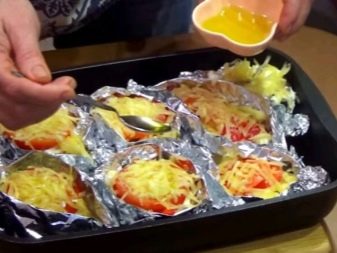
Should you pierce?
Theoretically, if you build a sealed container from foil and squeeze it on all sides so that there is no room for steam and emerging liquid inside, it can burst. But in practice, such cases are quite rare. After all, the seams, no matter how you fix them, still allow air and steam to pass through. For peace of mind, you can make a couple of punctures, but only in the upper part.
To a large extent, the question of the need for punctures depends on personal tastes and the desired result. The more holes for the outflow of steam, the less liquid will remain inside. But this way the dish can turn out to be harsh and dry. And if you overexpose it, it can burn at all.

If it is important to keep meat or fish juicy, they should be completely closed; it is undesirable to pierce the foil covering them.
In addition, cooking times in a closed container are reduced.
Many people complain that foil-wrapped dishes do not look very attractive. Usually this problem is solved as follows:
- at the first stage, foil is needed so that everything is baked well and remains juicy;
- then 10-15 minutes before the end of cooking, the foil from the top can be removed completely or cut and pushed aside; at the same time, the accumulated liquid from the bottom will not go anywhere, and the top will brown and look more attractive.
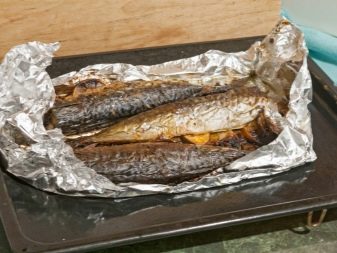

What can be replaced?
If the recipe contains foil, but it is not at hand, or the roll has ended unexpectedly, you can get out of the situation, using other accessories.
- A baking sleeve is suitable as an airtight container. Unlike foil, it does not hold its shape and requires fastening the holes on the sides with special clips.After cooling, the sleeve can stick to the baked food, so it's better not to hesitate to serve them. In this case, steam outflow holes are required.
- You can use paper (parchment) to line the bottom of a baking sheet or mold. Products do not stick to it even without lubrication. Alternatively, you can use a rug - it is similar in properties to parchment paper, is reusable, but may not fit.
- Instead of building foil molds, spending time and effort on this, you can purchase ready-made ones. Foil molds can be disposable or reusable. They can be used to bake pastries, make casseroles and even freeze food.
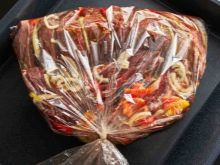
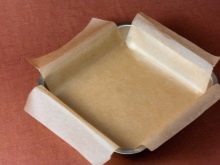
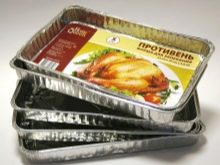
In principle, instead of foil, you can use conventional forms (open and with lids), baking sheets, pans, pots and other suitable heat-resistant dishes. However, not all of them will be truly comfortable. In addition, dirty dishes with dried and burnt food debris can be difficult to clean. Therefore, it is better to have several rolls of foil in reserve. As a last resort, it can be found in almost any grocery or hardware store.
Which side of the foil to use when baking, see below.








